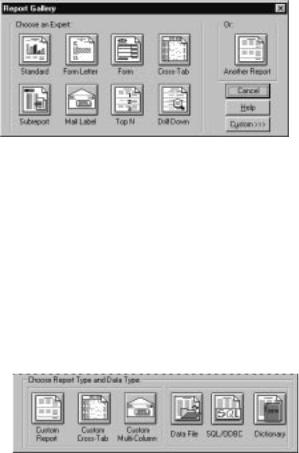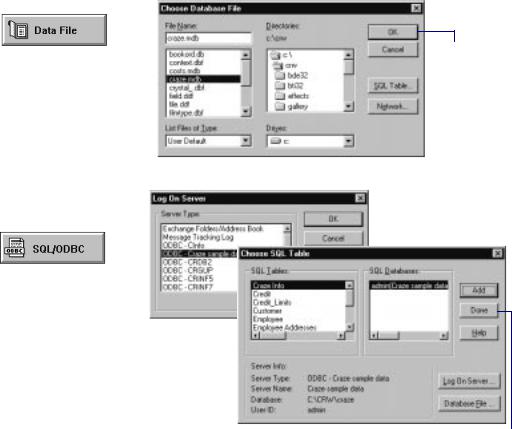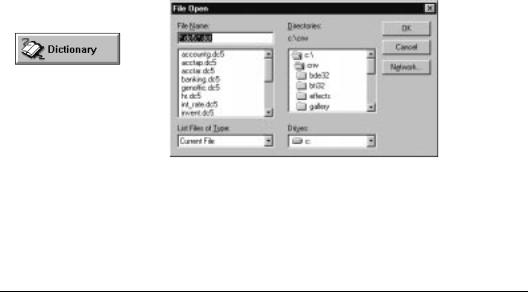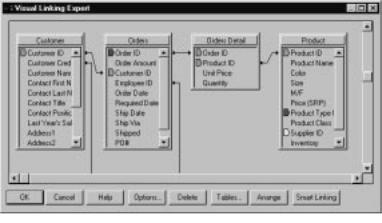
- •Welcome to Seagate Crystal Reports
- •Welcome
- •Two kinds of Hands-On tutorials
- •Command, button, key, and control conventions
- •Using Seagate Crystal Reports documentation
- •Seagate Crystal Reports online Help features
- •If you need more help...
- •Installation Requirements
- •Installing Seagate Crystal Reports
- •Installing on a network workstation
- •Upgrading from a previous version
- •Quick Start
- •Subreports expand report usefulness
- •Query Designer adds ad-hoc querying capabilities
- •Parameter fields mean multi-purpose reports
- •Text objects give you text with intelligence
- •Preprinted-form reports easier than ever
- •More powerful formulas extend your capabilities
- •Web solution serves up variety of online reports
- •HTML exporting simplifies Web activities
- •New database support improves data access
- •Running totals made easy
- •Smart Navigation
- •Learning Seagate Crystal Reports
- •User’s Guide
- •Online Help
- •Books Online
- •Sample Reports
- •Glossary
- •Sample Data - CRAZE.MDB
- •Suggested learning paths
- •The application window
- •Menu bar
- •Standard toolbar
- •Supplementary toolbar
- •Format bar
- •Status bar
- •Shortcut menus
- •Cursors
- •Design Tab
- •Preview Tab
- •Other fundamentals
- •HANDS-ON (Report Design Environment)
- •How to add, delete, and move guidelines
- •How to move and position objects using guidelines
- •How to turn the grid on/off
- •How to zoom your report in and out
- •How to undo/redo activities
- •How to drill down on summarized data
- •HANDS-ON (Sections and Areas)
- •How to add, delete, move, and merge sections
- •How to split and resize sections
- •Basic report design
- •How to design a prototype
- •Concepts in reporting
- •Beyond basic reports
- •HANDS-ON (Report Creation and Design)
- •How to select data and begin creating a report
- •How to add and link multiple tables
- •How to insert database fields
- •How to insert special fields
- •How to insert a page n of N field
- •How to insert text objects
- •How to use a database field in a text object
- •How to insert a picture
- •How to select, move, and resize objects
- •How to hide parts of the report
- •HANDS-ON (Finishing Your Report)
- •How to insert page headers and footers
- •How to add a title page to your report
- •How to add summary information to your report
- •Printing considerations
- •Design solutions for printing/distributing
- •Report creation checklist for distributed reports
- •Updating printer drivers
- •Report distribution
- •HANDS-ON (Distributing Your Report)
- •How to export reports
- •How to fax a report
- •How to request reports from a web browser
- •How to specify parameter field values
- •How to log on to a database
- •How to view plain HTML reports
- •Overview
- •Getting started
- •Record Selection
- •Grouping and sorting
- •Completing the report
- •Introduction
- •Working with Arbor Essbase data
- •HANDS-ON (Reporting on OLAP data)
- •How to create a cross-tab with Essbase data
- •Using multiple sections in reports
- •HANDS-ON (Multiple Section Reports)
- •How to work with text objects
- •How to create a form letter using a text object
- •How to format objects conditionally
- •How to print conditional messages in form letters
- •How to alternate background colors for rows
- •How to eliminate blank lines
- •How to add blank lines conditionally
- •Formatting concepts
- •Absolute formatting
- •Types of formatting properties
- •Conditional formatting
- •HANDS-ON (Absolute Formatting)
- •How to add color, shading, and borders
- •How to add/edit lines and boxes
- •How to change margins
- •How to add/delete white space between rows
- •How to set page orientation and paper size
- •HANDS-ON (Conditional Formatting)
- •How to flag values that meet certain conditions
- •Record selection
- •Group selection
- •Record selection formula templates
- •HANDS-ON (Record and Group Selection)
- •How to create a record or group selection formula
- •How to use record/group selection templates
- •How to select the top or bottom N groups
- •Sorting, Grouping, and Totalling Overview
- •Creating custom groups
- •HANDS-ON (Sorting, Grouping, and Totalling)
- •How to do a single field sort
- •How to do a multiple field sort
- •How to group data
- •How to sort records within groups
- •How to summarize grouped data
- •How to subtotal grouped data
- •How to sort based on summarized group values
- •How to create multiple levels of subtotals
- •How to group data in intervals
- •How to calculate a percentage of the grand total
- •How to create group headers
- •What are formulas?
- •Other formula conventions
- •Formula syntax
- •How formulas are evaluated - Order of precedence
- •HANDS-ON (Formulas 101)
- •How to insert a formula in your report
- •How to delete formulas from your report
- •How to copy formulas from online Help
- •How to copy formulas from one report to another
- •How to create if-then-else formulas
- •How to format text with formulas
- •How to use variables in formulas
- •How to declare a variable
- •How to assign a value to a variable
- •How to conditionally assign values to variables
- •How to use an array in a formula
- •How to use a range in a formula
- •How to use semicolons in formulas
- •How to fine tune group selection formulas
- •How to fine tune record selection formulas
- •How to debug a formula
- •Introduction
- •HANDS-ON (Advanced Totalling)
- •How to maintain running totals in a list
- •How to subtotal running totals within groups
- •How to subtotal without grouping
- •How to subtotal true A to B, A to C reports
- •Parameter field objects overview
- •Multiple parameter fields
- •Parameter field considerations
- •HANDS-ON (Parameter Field Objects)
- •How to create a parameter field
- •How to use a parameter field in a formula
- •How to respond to parameter field prompts
- •How to use wildcards with parameter fields
- •How to set a report title using parameter fields
- •How to set sort order using parameter fields
- •Graphing Overview
- •Choosing a graph or chart type
- •Where to place your graph
- •Data you can graph on
- •Before you create your graph
- •HANDS-ON (Graphing)
- •How to graph on a summary or subtotal field
- •How to graph on a details field
- •How to graph on a formula field
- •How to graph on cross-tab summaries
- •How to edit graphs using PGEditor
- •How to use the underlay feature with graphs
- •OLE Objects Overview
- •Inserting OLE objects in your reports
- •Linked vs. Embedded Objects
- •The dynamic OLE menu commands
- •OLE and the Picture command
- •General OLE considerations
- •HANDS-ON (OLE Objects)
- •How OLE objects are represented in your report
- •How to use OLE - General Overview Tutorial
- •How to insert a graphic/picture as an OLE object
- •What are subreports?
- •Unlinked vs. linked subreports
- •How subreport linking works
- •HANDS-ON (Subreports)
- •How to insert a subreport
- •How to preview your subreport
- •How to combine unrelated reports using subreports
- •How to use subreports with unlinkable data
- •Cross-tab overview
- •Cross-tab components
- •HANDS-ON (Cross-Tab Objects)
- •How to create a cross-tab object
- •How to format a cross-tab
- •How to print cross-tabs that span multiple pages
- •The Crystal Query Designer
- •HANDS-ON (Queries)
- •How to create a new query
- •How to add tables to a query
- •How to link tables and specify a join type
- •How to add fields to a query
- •How to identify unique values in a query
- •How to summarize data with aggregate functions
- •How to sort records according to field values
- •How to specify records to be included in a query
- •How to select groups to be included in a query
- •How to create an SQL expression
- •How to create a query from another Crystal Query
- •How to select a query for a report
- •How to use a parameter field in a query
- •Dictionaries Overview
- •HANDS-ON (Dictionaries)
- •How to create a new dictionary
- •How to add a data file
- •How to open an SQL or ODBC data source
- •How to link multiple tables
- •How to select tables and fields for users
- •How to add/create formulas
- •How to move fields/field headings within the list
- •How to update the location of a database table
- •How to add a new field heading
- •How to add Help text
- •How to add a graphic
- •How to create sample data for users to browse
- •How to edit an existing dictionary
- •How to convert a 3.x or 4.x dictionary file
- •How to select a dictionary for a report
- •Databases Overview
- •For additional information
- •HANDS-ON (Working With Databases)
- •How to open Access queries through DAO
- •How to open Access queries through ODBC
- •How to open Access parameter queries
- •How to set up an ODBC data source
- •How to check settings for an ODBC data source
- •How to log on to an ODBC data source
- •How to add an ODBC database table to a report
- •How to log on to MS SQL Server via ODBC
- •How to log off an ODBC data source
- •How to set up an A to B, A to C link
- •How to edit an SQL query
- •How to use an ACT! database
- •How to open the NT Event Log
- •Introduction
- •Four types of data
- •Direct access database files
- •ODBC data sources
- •Crystal Query Designer files
- •Crystal Dictionary files
- •Multi-pass reporting
- •Product support
- •Web support
- •E-mail support
- •Fax support
- •Telephone support
- •Extended technical support policy
- •Product registration
- •Product return policy
- •Product replacement policy
- •Glossary

state (average summary on the sales field) and calculate the number of products sold in the state (distinct count of the product name field).
See How to summarize grouped data, Page 289, and How to subtotal grouped data, Page 291.
Beyond basic reports
Once you are comfortable with the basics of reporting, you will be ready to investigate powerful reporting features including:
●graphs (see Graphing, Page 405),
●OLE objects (see OLE, Page 415),
●form letters (see How to create a form letter using a text object, Page 218),
●subreports (see Subreports, Page 429),
●cross-tabs (see Cross-Tab Objects, Page 445),
●multi-section reports (see Multiple Section Reports, Page 213),
●and much, much more.
HANDS-ON (Report Creation and Design)
How to select data and begin creating a report
You can use Experts to help you create reports as quickly as possible. When you click the NEW REPORT button on the standard toolbar, the Report Gallery appears. In the Report Gallery you will find a series of buttons representing the different types of Experts that are at your disposal.
Reporting 101 |
113 |

●Click the icon for the type of report you want to create and follow the steps outlined on the tabs in the Expert that appears.
●If you want to build a new report based upon one that already exists, click the Another Report button. You can select a report file to serve as a template for your new report. The program will make a duplicate of that original report, which you can modify however you please.
●If you want to build a report from scratch, click the Custom button. Several Report Type and Data Type icons will appear at the bottom of the Report Gallery. Click the buttons appropriate to your needs.
The program will open a dialog box that enables you to select the data you need. Since building reports from scratch is the easiest way to learn about all the powerful features of the program, this is the method discussed throughout the documentation. For information on creating reports from another report, see
ANOTHER REPORT, Page 106, and search for Report Templates in Seagate Crystal Reports online Help and Sample Reports in Sample Reports online Help.
114 |
Seagate Crystal Reports User’s Guide |

If you choose Data File |
1 Using the File Name and Directories |
as your data source... |
list boxes, select the desired file. |
2 Click OK to add the file to your report.
If you choose SQL/ODBC
as your data source...
1 First, choose the Server Type.
2 Then, using the SQL Tables and SQL Databases list boxes, select the desired table and click OK.
3 Click done once you have added all you want.
Reporting 101 |
115 |

If you choose Dictionary as your data source...
1 Using the File Name and Directories list boxes, select the desired file.
2 Click OK to open the file and add it to your report.
Related Topics
Data Sources, Page 583
How to select a dictionary for a report, Page 510
How to add and link multiple tables
After you have selected a database table to begin working on your report, you may need to select a second table and then link the tables so the records in each table match up. For example, if you are using a Customers table and an Orders table for your report, you will need to link the tables so the records in the Orders table are matched up with the records of the customers who placed the orders.
Choose the ADD DATABASE TO REPORT command from the Database menu. The Choose Database File dialog box appears.
Using the Directories, Drives, and File Name boxes, select the new database that you want to use in the report and click OK when finished. The Visual Linking Expert appears and displays the databases currently available for linking. Search for Visual Linking Expert in Seagate Crystal Reports online Help.
NOTE: If the Auto-Smart Linking option is toggled on in the
Database Tab of the File Options dialog box, you will not have to
116 |
Seagate Crystal Reports User’s Guide |

manually create links between the tables. See Linking tables, Page 520, and search for File Options dialog box in Seagate Crystal Reports online Help.
NOTE: If your primary database is either Access or Btreive, all tables contained in those databases will appear in the Visual Linking Expert. You do not have to manually add each table to your report.
To create links manually, drag a field from one table to a field in another table. If successful, a link line is created. If unsuccessful, a message is issued.
|
|
|
|
|
|
Click OK when |
To specify the tables, |
|
To link databases automatically, |
||
|
|||||
finished. |
click the Tables button. |
click the Smart Linking button. |
|||
NOTE: When manually creating links, the field you are linking “to” field must be an indexed field. For more information on indexed fields and tables, see Indexed tables, Page 518.
The Visual Linking Expert closes, and you are returned to your report. The linked databases are now available to use. If you are not satisfied with the link, you can modify it using the Visual Linking Expert. Search for Visual Linking Topics Index in Seagate Crystal Reports online Help.
Related Topics
Working With Databases, Page 513
SQL join types (ODBC data sources), Page 537
Reporting 101 |
117 |
